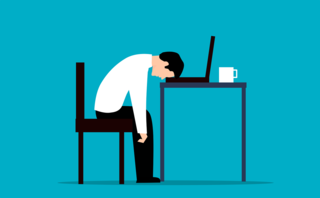Career
Stanford Professor on "Zoom Fatigue" and How to Prevent It
Jeremy Bailenson on the psychological consequences of video conferencing.
Posted March 4, 2021 Reviewed by Ekua Hagan

Why do people feel exhausted after spending hours in virtual meetings? Recently, Stanford professor and founding director of the Stanford Virtual Human Interaction Lab (VHIL), Jeremy Bailenson, published a paper in Technology, Mind, and Behavior about the potential psychological factors that cause “Zoom fatigue.”
“While there are dozens of empirical studies in psychology, human-computer interaction, and communication that examine behavior during videoconferencing, there has yet to be rigorous studies that examine the psychological consequences of spending hours per day on this particular medium,” wrote Bailenson. “Hence this piece outlines a theoretical explanation—one based on previous work—as to why the current implementation of videoconferencing is so exhausting.”
Video conferencing, also called web conferencing, online meetings, webcasts, web meetings, videoconferencing, virtual meetings, and webinars, refers to real-time meetings between two or more people in separate geographic locations through the transmission of video and audio over the internet.
The video conferencing worldwide market size is projected to reach $10.92 billion by 2027, with a compound annual growth rate (CAGR) of 9.7 percent during 2020-2027 according to a report by Fortune Business Insights. On Monday, Zoom Video Communications, Inc. reported that fourth-quarter total revenues were up 369 percent year-over-year. In addition to Zoom Video Communication Inc., other companies with video conferencing solutions include Cisco Systems, Inc. (WebEx), Adobe Systems (Adobe Connect), Citrix (GoToMeeting), Microsoft Corporation (Microsoft Teams), Logitech International SA, Polycom Inc., Verizon Communications Inc., Avaya Inc., Alphabet Inc. (Google Meet), Facebook, Inc., ON24, ClickMeeting, and many more.
“As opposed to discussing videoconferencing generally, I focus on Zoom in particular,” Bailenson wrote. “I don’t do this to vilify the company—I am a frequent Zoom user, and I am thankful for the product which has helped my research group stay productive and allowed friends and family to stay connected. But given it has become the default platform for many in academia, and readers of this article are likely familiar with its affordances, it makes sense to focus on Zoom.”
Bailenson attributes several factors to video conferencing exhaustion—prolonged eye gaze at a close distance, cognitive overload due to nonverbal communications, the impact of staring at an “all day mirror,” and reduced mobility.
Eye gazing for prolonged periods in social situations can be uncomfortable. An Oxford University study by Michael Argyle and Janet Dean published in Sociometry in 1965 showed that nonverbal behavioral research has shown that prolonged eye gazing during social interaction arouses anxiety. Another study published in PLOS ONE in 2019 by Marcel Takac and his colleagues shows that being stared at while speaking causes physiological arousal.
Prolonged virtual eye gazing in social settings, like eye-gazing in person, can also arouse anxiety. Bailenson and colleagues published a study in Personality and Social Psychology Bulletin in 2003 that showed that participants gave greater personal distance from approaching virtual humans when engaging in mutual gazes than when not.
Bailenson also uses the analogy of eye-contact avoidance in an elevator. “In the elevator, when faces are larger—that is, when people are closer, riders can solve this by looking down,” Bailenson wrote. ”Everyone reduces the amount of mutual gaze to a minimum. On Zoom, the opposite happens.”
One of the challenges of virtual meetings is that nonverbal cues are difficult to send and receive, causing cognitive overload. Although video conferencing offers the ability to visibly communicate nonverbal cues, Bailenson posits that “users need to work harder to send and receive signals.”
“Users are forced to consciously monitor nonverbal behavior and to send cues to others that are intentionally generated,” he wrote. “Examples include centering oneself in the camera’s field of view, nodding in an exaggerated way for a few extra seconds to signal agreement, or looking directly into the camera (as opposed to the faces on the screen) to try and make direct eye contact when speaking. This constant monitoring of behavior adds up.”
The cognitive overload is bi-directional. “Users are constantly receiving nonverbal cues that would have a specific meaning in a face-to-face context but have different meanings on Zoom,” he wrote.
Bailenson also compares the user real-time camera image to a mirror which may lead to self-evaluation and stress based on prior research studies. “Zoom users are seeing reflections of themselves at a frequency and duration that hasn’t been seen before in the history of media and likely the history of people (with exceptions for people who work in dance studios and other places that are full of mirrors),” he wrote.
Video conferencing is typically done using a computer which places limits on mobility if a user wants to stay in view of the camera. “In essence, users are stuck in a very small physical cone, and most of the time this equates to sitting down and staring straight ahead,” wrote Bailenson. “During face-to-face meetings people move. They pace, stand up, and stretch, doodle on a notepad, get up to use a chalkboard, even walk over to the water cooler to refill their glass. There are a number of studies showing that locomotion and other movements cause better performance in meetings.”
Fortunately, there are easy workarounds to prevent video conferencing exhaustion according to Bailenson. To reduce the prolonged eye contact with a screen full of close-up faces, do not use the full-screen option, instead minimize the web conferencing window size. Consider using an external keyboard and external camera to increase mobility. Turn off the “all day mirror” by selecting to hide the self-view and decrease the cognitive nonverbal load by turning off the video during meetings whenever possible.
Copyright © 2021 Cami Rosso All rights reserved.




